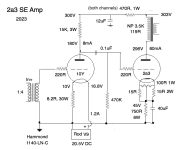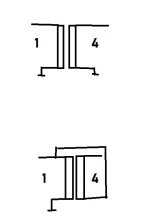I am adding to this thread, instead of opening the n-th thread about OTPs.
I am in the market for a couple of high quality OPTs for a 300B SET amplifier (5.6K, 10W, 60mA), and these are in my list.
Monolith Magnetics SX-11 => Inquire sent, no reply yet
AE Europe => Amorphous Core 12W, ~750/each. On the paper AE OPTs performs amazingly but I haven't heard any in real life
Audio Feast => FM-24WS Finemet nanocrystals ( ~$720/each). This should be the very good Noguchi's
Intact audio => Nickel core (waiting for price)
Intact audio => Amorphous core (waiting for price)
Anyone has any experience (good or bad) with the above iron builders?
I haven't put any Asian iron supplier in the list because they seem to be difficult to procure. Am I doing it wrong?
I am in the market for a couple of high quality OPTs for a 300B SET amplifier (5.6K, 10W, 60mA), and these are in my list.
Monolith Magnetics SX-11 => Inquire sent, no reply yet
AE Europe => Amorphous Core 12W, ~750/each. On the paper AE OPTs performs amazingly but I haven't heard any in real life
Audio Feast => FM-24WS Finemet nanocrystals ( ~$720/each). This should be the very good Noguchi's
Intact audio => Nickel core (waiting for price)
Intact audio => Amorphous core (waiting for price)
Anyone has any experience (good or bad) with the above iron builders?
I haven't put any Asian iron supplier in the list because they seem to be difficult to procure. Am I doing it wrong?
Just be aware that when you go from GOS to the more exotic alloys that the primary inductance for a lot of these designs drops rather substantially. With a 5K transformer, this can be a rather brutal hit to low frequency response that otherwise wouldn't be there with a transformer using M4 or M6 lams.
It's more a matter of less flux density available and less effective Afe (stacking factor) in exotic materials, such as nanocrystalline and amorphous cores.
If we assume
Bmax = 1.4T* for GOSS
Bmax = 1.0T* for nanocrystalline, amorphous,
Where some knee in the saturation curve begins,
And we assume GOSS has a filling factor of 0.93 vs 0.78 for nano/amorphous.
We could multiply 1.4T x 0.93 and compare 1.0 x 0.78, which gives 1.67 more flux density headroom per raw core area for GOSS. Hence it is preferred where higher power, inductance vs Idc are needed for a smaller transformer size.
If we assume
Bmax = 1.4T* for GOSS
Bmax = 1.0T* for nanocrystalline, amorphous,
Where some knee in the saturation curve begins,
And we assume GOSS has a filling factor of 0.93 vs 0.78 for nano/amorphous.
We could multiply 1.4T x 0.93 and compare 1.0 x 0.78, which gives 1.67 more flux density headroom per raw core area for GOSS. Hence it is preferred where higher power, inductance vs Idc are needed for a smaller transformer size.
Monolith does account for that in some of their transformers and you'll note some where the A and X versions weigh more and don't have the inductance issue. Personally I'd rather give my money toward a design like that rather than one where the lamps are swapped with no other alterations.
FWIWI am adding to this thread, instead of opening the n-th thread about OTPs.
I am in the market for a couple of high quality OPTs for a 300B SET amplifier (5.6K, 10W, 60mA), and these are in my list.
Monolith Magnetics SX-11 => Inquire sent, no reply yet
AE Europe => Amorphous Core 12W, ~750/each. On the paper AE OPTs performs amazingly but I haven't heard any in real life
Audio Feast => FM-24WS Finemet nanocrystals ( ~$720/each). This should be the very good Noguchi's
Intact audio => Nickel core (waiting for price)
Intact audio => Amorphous core (waiting for price)
Anyone has any experience (good or bad) with the above iron builders?
I haven't put any Asian iron supplier in the list because they seem to be difficult to procure. Am I doing it wrong?
My experience with the transformers mentioned above (Monolith and AE, I don't know the other ones) is that the Monolith are superior to the AE ones.
I know I'll get a few haters replying the opposite but this is just my personal experience with the OPT mentioned above.
BTW two old AE OPT I purchased form a DIY guy here in the Netherlands, dropped out after a few weeks and it was an internal malfunction so be aware and make sure you have at least a few years warranty if you go for the NEW AE OPT. If they work, they sound great, but nothing compared to the Monolith, the later is more refined and 3D with more texture in the Bass instead of a dry punch in the bass like the AE's.
At the moment I use the Menno van der Veen OPT (10kg heavy) SE. It's one of the best ever made regarding Bass punch and finesse. You may consider that one my type is the
VDV-HQ-5090-SES
Just my two centsThank you all for sharing your thoughts.
It seems like the consensus is that Monolith Magnetics makes high quality OPTs. I asked them for a quote a few days ago through their website, but I haven't received a response yet.
Maybe I'll give them a phone call one of these days.
@audiowize
Thank you for your observation regarding the relationship between primary inductance and low cutoff frequency.
The primary inductance of the SX-11 is specified at L=24H, and its cutoff frequency is specified -3dB at 6Hz on a 8 ohm load, although they don't specify the type of source they used to perform the measurement (most likely a voltage generator with low output impedance).
I should run a simulation to estimate the low cutoff frequency in my amplifier's specific configuration.
It seems like the consensus is that Monolith Magnetics makes high quality OPTs. I asked them for a quote a few days ago through their website, but I haven't received a response yet.
Maybe I'll give them a phone call one of these days.
@audiowize
Thank you for your observation regarding the relationship between primary inductance and low cutoff frequency.
The primary inductance of the SX-11 is specified at L=24H, and its cutoff frequency is specified -3dB at 6Hz on a 8 ohm load, although they don't specify the type of source they used to perform the measurement (most likely a voltage generator with low output impedance).
I should run a simulation to estimate the low cutoff frequency in my amplifier's specific configuration.
Two other transformer companies you could consider is Tribute (which may no longer be in business), and O'Netics.
When shopping for transformers, you should consider if your 300B amps will be for higher frequencies only, lower frequencies only or full range.
Another issue is whether you will consider parallel feed, including wiring the OPT as an autoformer, or go the conventional route with series feed.
These issues will help to guide your decision.
I am using Magnequest permaloy OPTs (wired as autoformers) for my parallel feed, SE 300B amps. My understanding is that nickel tranformers are particularly sweet for higher frequencies - my SE amps handle frequencies 500 hz and above.
Retsel
When shopping for transformers, you should consider if your 300B amps will be for higher frequencies only, lower frequencies only or full range.
Another issue is whether you will consider parallel feed, including wiring the OPT as an autoformer, or go the conventional route with series feed.
These issues will help to guide your decision.
I am using Magnequest permaloy OPTs (wired as autoformers) for my parallel feed, SE 300B amps. My understanding is that nickel tranformers are particularly sweet for higher frequencies - my SE amps handle frequencies 500 hz and above.
Retsel
@audiowize I simulated both the MM S-11 (FeSi, Lp=37H) and the SX-11 (Nanocrystalling Lp=24H).
Although the SX-11 cutoff frequency is higher than the S-11, it's still pretty good with a -.5dB point at 22.5Hz and -0.6dB at 20Hz.
The S-11 attenuates only -03dB at 20Hz. I am wondering if those 0.3dB at 20Hz really make a difference to the ear..


Although the SX-11 cutoff frequency is higher than the S-11, it's still pretty good with a -.5dB point at 22.5Hz and -0.6dB at 20Hz.
The S-11 attenuates only -03dB at 20Hz. I am wondering if those 0.3dB at 20Hz really make a difference to the ear..
I haven't heard a bad word about Monolith Magnetics yet.
Comparing the SX-9 (3k3) with the SX-11 (5k), I just find it noteworthy that the SX-11 has RDC over 300R, while the SX-9 has 106R. 5k needs more inductance, so more RDC, but 3x the RDC for only 1H more (24H instead of 23H) inductance?? Values for leakage and inductance also vary by a factor ~2, so the construction/winding of both is probably pretty different.
It is standard to take 20Hz as lowest frequency, but I just ask how many speakers do actually play down to 20Hz. (But inductance is also important for low distortion at the lowest frequencies).
Comparing the SX-9 (3k3) with the SX-11 (5k), I just find it noteworthy that the SX-11 has RDC over 300R, while the SX-9 has 106R. 5k needs more inductance, so more RDC, but 3x the RDC for only 1H more (24H instead of 23H) inductance?? Values for leakage and inductance also vary by a factor ~2, so the construction/winding of both is probably pretty different.
It is standard to take 20Hz as lowest frequency, but I just ask how many speakers do actually play down to 20Hz. (But inductance is also important for low distortion at the lowest frequencies).
- Home
- Amplifiers
- Tubes / Valves
- Best 300B SE OPT?

